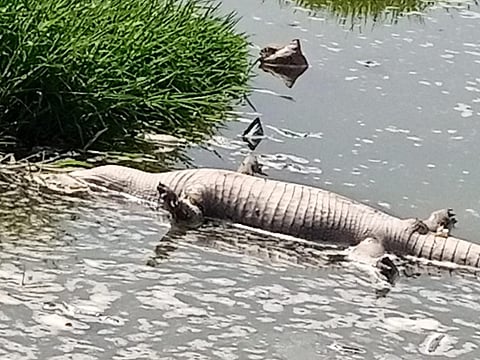

Some 50 mugger crocodiles have died in the last one month in a prominent waterbody of Rajasthan’s Kota city as a result of it being filled up for developmental activities, locals and wildlife activists have alleged.
The Kala Talab (‘black pool’) is connected via a canal to the Chambal river. It is rich in aquatic life including mugger crocodiles.
“As long as I have known, there have been crocodiles in the Kala Talab,” Tapeshwar Singh Bhati, a wildlife activist in the city, told Down To Earth.
But of late, wildlife activists and locals have observed that the pond itself, and the crocodile habitat is in danger due to the development activities taking place in the city.
“The Urban Improvement Trust (UIT) is coming up with a development project worth Rs 20 crore in the area. They are filling up the water body with fly ash and soil to build residential colonies and parks. This is not just leading to the death of crocodiles, but is also killing other aquatic animals,” Bhati claimed.
There are 150 crocodiles in the pond and many types of fish, according to Mukundra Wildlife and Environment Society in Kota.
“Though the pond is huge, it has not been declared a wetland. So, the wetland laws do not apply to it, giving a freehand to the UIT authorities,” Bhati said. “However, the rules of the Wild Life (Protection) Act, 1972, are applicable here as it concerns a Schedule I animal,” he added.
Bharat Singh, a member of the Rajasthan Legislative Assembly and of the state wildlife board, took cognizance of the situation and wrote a letter to Shreya Guha, the principal secretary, forest and environment, asking for a departmental probe into the matter.
“This is very unfortunate, but is a country-wide reality. Water bodies and natural habitats of many animals are in danger due to so-called developmental activities. The higher authorities cannot disregard or overlook the letter, but I am not naïve enough to believe that if any action is taken, it is because of my letter,” Singh said.
Bhati further alleged that locals living near the pond have vested interests and help in covering up the matter.
“When the authorities of UIT see that a crocodile carcass is floating on the water’s surface, they bury it then and there to hide proof. Though we have photographic evidence, we have not been able to send a crocodile carcass for post mortem to ascertain the cause of death. The locals also do not inform the wildlife department,” Bhati said.
Brijesh Vijayvergiya, state president of the Rashtriya Jal Biradri (National Water Community), a network of non-profits, activists and researchers working on water said Kota’s groundwater levels had gone down in the last few decades due to filling up of local ponds and streams (nallahs).
“Many such ponds like Chaturpur talab, Anantpura talab, etc have been filled in the past to create residential colonies while Kishor Sagar Talab has shrunk to half of its original size. The same is now happening with Kala Talab.
“Because of filling up of these local waterbodies, ground water cannot get recharged and despite being on the banks of the Chambal, people here have to depend on water tankers throughout the year. It is necessary to protect the last remaining water bodies now,” Vijayvergiya said.
DTE reached out to UIT for their comments but received no response.